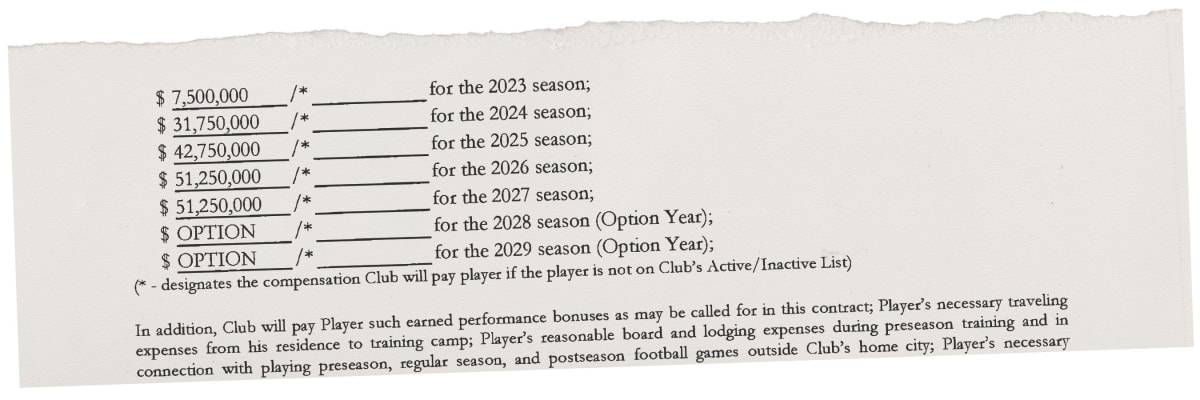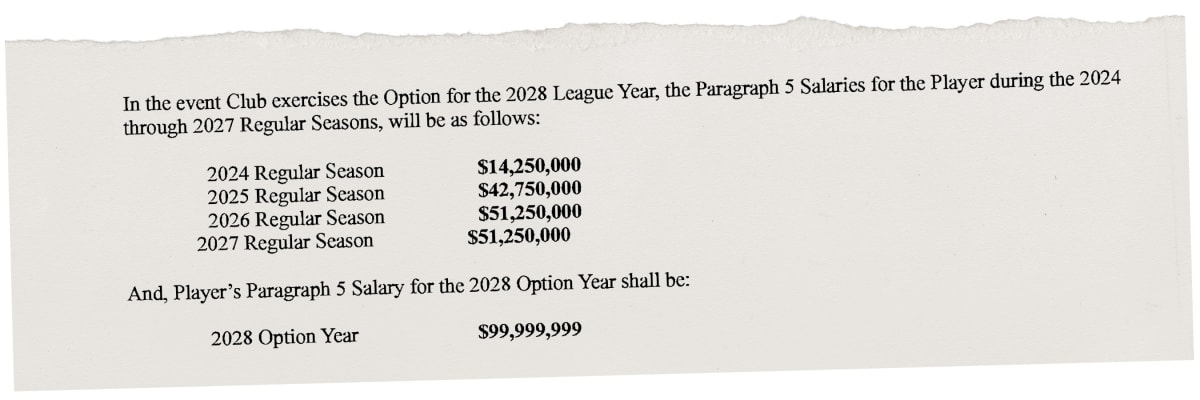This story is part of Sports Illustrated’s exploration of the ways sports and finance intertwine—from the NIL revolution to online betting, business-minded athletes and more. For more on sports and money, see SI’s October 2023 Money Issue.
My crash course in the nuances of an NFL contract could not be going worse. For starters, I printed the contract double-sided, and, as I understand now, we are never to print the contract double-sided. I shuffled the pages out of order. And, as should be apparent from my college degree from sportswriting, I suck at math.
Luckily my contract tour guide, who requested anonymity in exchange for their candor, is patient. They’re also an expert in these things, having helped negotiate several NFL deals. Sports Illustrated acquired a copy of the five-year, $260 million contract signed in April by Ravens quarterback Lamar Jackson, and we’re studying it now so I can learn exactly what goes into such a life- and league-changing deal.

There are plenty of oddities in NFL contracts. In deals struck by the Colts and Chargers, there is a provision preventing a player from wearing team colors during marketing and media activities not sanctioned by the team. Near the end of Patrick Mahomes’s contract, the Chiefs lay claim to any “physical exertion whatsoever,” which should make us wonder about those backyard games of tag with the children. Deshaun Watson has to appear on ClevelandBrowns.com for interviews for up to four hours per month, but Jalen Hurts has to appear for only up to two hours each month on Eagles channels. Some teams have their innate quirks, be it a certain structure to trigger the payment of guaranteed money or unique legalese. Some agents can identify which team put together a contract, even with all the names and numbers blacked out.
Despite the rather unusual circumstances by which this contract came to be (Jackson, who does not have an agent, negotiated it on his own), the quarterback’s agreement is considered pretty standard fare. This makes it a window into the modern NFL, where the negotiating points go way beyond the dollar figures. Here are three telling details buried deep in Jackson’s deal.
Jackson understood himself and got the money up front

Typically, when a deal is reported in the media, the headline is the average annual value—the total amount of money divided by the years the contract covers. This is the metric most coveted when a player wants to be considered the highest paid at his position.
But on page 6 of Jackson’s contract, in the Signing Bonus Addendum, we see a suggestion of another metric he was trying to conquer: cash flow. Jackson not only wanted to be the NFL’s highest-paid player (he eclipsed Hurts, who signed 10 days earlier for an average of $51 million, by $1 million annually; though he has since been passed by Justin Herbert and Joe Burrow), but he also wanted to get as much money as possible as soon as possible.
To that end, Jackson’s signing bonus was $72.5 million, which, when added to his 2023 salary, makes a cool $80 million in his first year. He received $52.5 million of that sum within 10 days of signing. The remainder will be paid in 18 equal installments during the regular season. In Year 2, Jackson is due $31.75 million, plus $750,000 in offseason workout bonuses, which makes his two-year “cash flow” $112.5 million. Jackson, according to reports, had the largest cash flow over three years ($156 million) in NFL history at the time of signing. Hurts, despite having a similar AAV, will receive $106.3 million over three years.
Both QBs are used heavily in the run game and thus are at an increased injury risk. Our contract expert notes that if a player gets hurt or declines as a contract matures, teams have various ways to recoup unpaid money that is theoretically “guaranteed.” By maximizing cash flow, Jackson smartly protected himself.
Jackson’s contract contains a ridiculous 2028 salary

On page 9 there is an eye-catching Option Addendum: If the Ravens exercise their option for the 2028 season—when the QB will be 31—he’ll receive a salary of $99,999,999. It sounds like what Dr. Evil would ask for in return for not blowing up the moon. But my expert says ignore this clause. It’s meaningless.
This addendum is little more than a ploy to extend the period over which the Ravens can spread out Jackson’s compensation for salary cap purposes. In reality, that option year actually ends the contract after ’27. Confused? Just wait. It gets weirder.
According to an agent I spoke with in addition to our contract expert, Baltimore could have put any number there—$1, $40 million, six easy payments of $19.99. Here’s how it works: By the sixth day of the league year in 2024, the Ravens have to notify Jackson if they are picking up his option for ’28, which would theoretically trigger the $99,999,999 salary. But picking up that option also triggers a contract clause on page 18 called the Voidable Years Addendum: “If Player is on Club’s roster on the last day of 2027 League Year, then Player’s contract for the 2028 and 2029 NFL League Years shall immediately and automatically be null and void.”
Picking up the 2028 option almost certainly guarantees Jackson would be on the roster on the final day of the ’27 league year. Per the contract, Jackson would get a bonus on the sixth day of the league year in ’24 worth $17.5 million because his option had been picked up—but the $99,999,999 would vanish because, per page 18, the ’28 contract year would be canceled.
Why bother with all this? The Ravens created additional, fictional years of Jackson’s contract to spread out (and decrease) the annual hit to their salary cap, which is calculated largely from a deal’s average annual value. Jackson will receive money on one schedule, but the Ravens can present to the NFL a piece of accounting that looks entirely different. Money that Jackson receives now can be socked away into their 2028 and ’29 cap years thanks to this clause, giving them salary cap space to spend now.
The Ravens like to know what their players are up to

After page upon page of granular legalese that all amounts to You’re going to get a pretty large chunk of money pretty soon, I am ready to exit this contract for good. But our expert reminds me that, while most contract codas are boring, some contain an M. Night Shyamalan–ian twist. For example, the famous but now deleted clause in Kyler Murray’s most recent Cardinals contract, which set a required amount of study time for the quarterback, had led to speculation that the team felt he wasn’t doing enough pregame homework.
At the back end of Jackson’s contract, we have no such luck. However, on page 16, Clause II, subsection IV, we find the following: “Player agrees to provide Club with the name and contact information of his Primary Marketing Representative and to keep the Club up to date with respect to any changes to his marketing representation.”
At first glance this would seem to be in reference to Jackson’s tight circle. His manager is his mother, Felicia Jones. But during his contract-negotiating period, the league office circulated a memo stating that an alleged business associate of Jackson’s, Ken Francis, was contacting teams on Jackson’s behalf and attempting to negotiate for him. Francis is not an NFLPA-certified agent. Jackson denied the report on the social media platform formerly known as Twitter.
Regardless of the truth of that report, it would make sense that Jackson might open himself up more to his potential as an athlete with commercial appeal. But it turns out the clause has nothing to do with the rumors about Jackson’s team and representation. It’s one of those contractual watermarks: Several Ravens players have it in their deals, and it pops up elsewhere, too. (Saints quarterback Derek Carr also has this requirement.) According to industry insiders, it is common for teams to keep track of who their players are dealing with, whether agents or marketing professionals. Some franchises make it a contract mandate.
Patrick Ricard, Baltimore’s hybrid fullback and defensive lineman, also has to account for who controls his marketing dollars. While neither Ricard nor Jackson seem to have many high-profile endorsement deals at the moment, one would assume there is more of a necessity to keep tabs on Jackson’s future business endeavors. Why require it in a contract? Because some team, somewhere, at some point in time, had no idea who to call.
If we’ve learned anything from this exercise, it’s that having someone who understands this wacky business is worth their weight in fictional option-year addendum gold. Jackson negotiated this deal on his own. In my mind, that makes him the most incredible quarterback I’ve ever seen both on and off the field.







